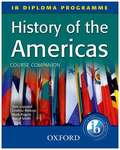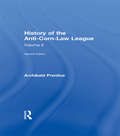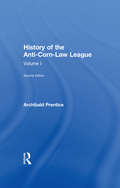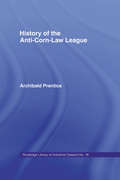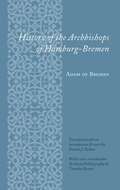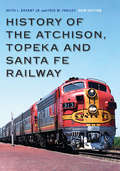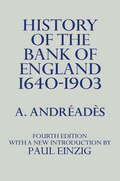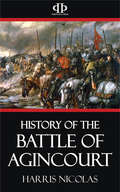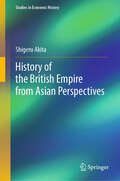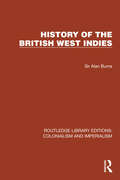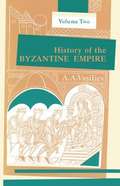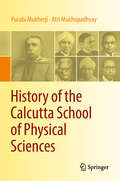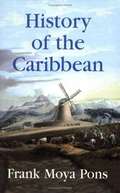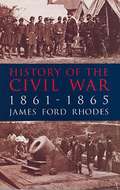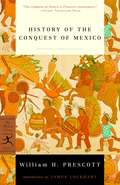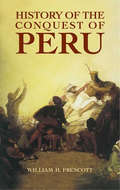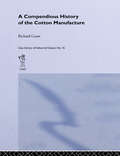- Table View
- List View
History of the Americas Course Companion: IB Diploma Programme
by David Smith Yvonne Berliner Tom Leppard Alexis Mamaux Mark D. RogersThis book covers 7 units out of 12 for option 3 of IB Higher Level History (units 1, 2, 5, 7, 9, 10 and 12), including source material for Canada, the United States, and a number of countries in Latin America. It provides exercises, exam questions and guidance on how to approach the exam to help students achieve exam success.
History of the Anti-Corn Law League
by Archibald PrenticeFirst Published in 1968. This second edition of the History of the Anti-Corn-Law League features a new introduction by W. H. Chaloner while the main text pursues the goal of cataloguing and archiving the timeline of events within the executive council. The beginning of 1848 saw workmen busily engaged in erecting the Free Trade Hall by which time it was supposed the Corn Law would be repealed. This remained standing, often used, until 1853, when its defeat showcased that the principles of free trade were fully recognized and the historical timeline for this edition begins.
History of the Anti-Corn Law League
by Archibald PrenticeFirst Published in 1968. This is Volume I of a series of studies in Economic and Social History series and looks at how the Corn Laws regulated the internal trade, exportation and importation and market development from the twelfth to the eighteenth centuries.
History of the Anti-Corn Law League
by Archibald PrenticeFirst Published in 1968. This is Volume I of a series of studies in Economic and Social History series and looks at how the Corn Laws regulated the internal trade, exportation and importation and market development from the twelfth to the eighteenth centuries.
History of the Archbishops of Hamburg-Bremen
by Timothy Reuter Adam of Bremen. Francis J. TschanAdam of Bremen's history of the see of Hamburg and of Christian missions in northern Europe from the late eighth to the late eleventh century is the primary source of our knowledge of the history, geography, and ethnography of the Scandinavian and Baltic regions and their peoples before the thirteenth century. Arriving in Bremen in 1066 and soon falling under the tutelage of Archbishop Adalbert, who figures prominently in the narrative, Adam recorded the centuries-long campaign by his church to convert Slavic and Scandinavian peoples. His History vividly reflects the firsthand accounts he received from travelers, traders, and missionaries on the peripheries of medieval Europe.
History of the Archbishops of Hamburg-Bremen (Records of Western Civilization Series)
by Adam of Adam of BremenAdam of Bremen's history of the see of Hamburg and of Christian missions in northern Europe from the late eighth to the late eleventh century is the primary source of our knowledge of the history, geography, and ethnography of the Scandinavian and Baltic regions and their peoples before the thirteenth century. Arriving in Bremen in 1066 and soon falling under the tutelage of Archbishop Adalbert, who figures prominently in the narrative, Adam recorded the centuries-long campaign by his church to convert Slavic and Scandinavian peoples. His History vividly reflects the firsthand accounts he received from travelers, traders, and missionaries on the peripheries of medieval Europe.
History of the Atchison, Topeka and Santa Fe Railway
by Fred W. Frailey Keith L. Bryant Jr.Cyrus K. Holliday envisioned a railroad that would run from Kansas to the Pacific, increasing the commerce and prosperity of the nation. With farsighted investors and shrewd management, the Atchison, Topeka and Santa Fe Railway grew from Holliday&’s idea into a model of the modern, rapid, and efficient railroad. There were many growing pains early on, including rustlers, thieves, and desperadoes as well as the nineteenth century&’s economic and climatic hardships. The railroad eventually extended from Chicago to San Francisco, with substantial holdings in oil fields, timber land, uranium mines, pipelines, and real estate. This is the first comprehensive history of the iconic Atchison, Topeka and Santa Fe Railway, from its birth in 1859 to its termination in 1996. This volume discusses the construction and operation of the railway, the strategies of its leaders, the evolution of its locomotive fleet, and its famed passenger service with partner Fred Harvey. The vast changes within the nation&’s railway system led to a merger with the Burlington Northern and the creation of the BNSF Railway. An iconic railroad, the Santa Fe at its peak operated thirteen thousand miles of routes and served the southwestern region of the nation with the corporate slogan &“Santa Fe All the Way.&” This new edition covers almost twenty-five more years of history, including the merger of the Santa Fe and Burlington Northern railroads and new material on labor, minorities, and women on the carrier along with new and updated maps and photographs.
History of the Bank of England
by A.M. AndreadesFirst Published in 1966. Routledge is an imprint of Taylor & Francis, an informa company.
History of the Battle of Agincourt
by Harris NicolasAbout the middle of the year 1414, Henry the Fifth, influenced by the persuasions of Chicheley, Archbishop of Canterbury, by the dying injunction of his royal father not to allow the kingdom to remain long at peace, or, more probably, by those feelings of ambition which were no less natural to his youth and personal character, than consonant with the manners of the times in which he lived, resolved to assert that claim to the crown of France, which his great-grandfather, Edward the Third, urged with such confidence and success...
History of the British Empire from Asian Perspectives (Studies in Economic History)
by Shigeru AkitaThis book presents the history of the British Empire as the “Bridge” for creating a Global History, especially emphasizing its connections with Asian regions. The United Kingdom ruled most of the world in the nineteenth century. Its influence spread around the globe in various forms – in the white settlements such as those in Canada, Australia, and New Zealand (Dominions), in Asian and African regions represented by present-day India, in colonies acquired by military force (Dependencies), and in other regions under its economic influence through trade and investment (the informal empire). Thus, the British Empire played a key role in nineteenth-century globalization. There are many books on the British Empire in English. However, no books from Asian perspectives have interpreted it as “the means used by Asian countries for their own economic development” (and as providers of “international public goods”). Along with the East Asian economic resurgence, the weight of the global system and the world economy has now largely shifted from the Atlantic world to the Asia-Pacific region, encompassing India, as well as the Pacific coast of the United States. The global depression in 2008 accelerated this trend. We now face the task of building a new interpretation of world history with a clearer understanding of this upheaval. Redrawing world history is not an easy task but a good starting point would be to analyze the mutual relationship between the British Empire and the Asian regions, and this can be done by interpreting the historical significance of the British Empire.
History of the British West Indies (Routledge Library Editions: Colonialism and Imperialism #31)
by Sir Alan BurnsHistory of the British West Indies (1954) examines the history of the islands of the Caribbean from their first discovery, through the periods of colonisation and slavery, and up to the beginnings of their status as independent nations. The actions of other nations are studied, as well as the British, as the various colonial powers vied for possession of these valuable possessions. Terrible cruelty was inflicted by colonial masters to the indigenous inhabitants, the slaves and indentured labour, and the worst of these are recorded in separate appendices.
History of the Buccaneers of America
by James BurneyA cross between genuine privateers, commissioned to defend a country's colonies and trade, and outright pirates, buccaneers were largely English, French, and Dutch adventurers who plied the waters among the Caribbean islands and along the coasts of Central America, Venezuela, and Colombia more than 300 years ago. The activities of these bands of plundering sea rovers reached a peak in the second half of the seventeenth century, when this remarkable eyewitness account was first published (1678).Alexander Exquemelin, thought to be a Frenchman who enlisted with the buccaneers for a time, chronicles the bold feats of these raiders as they ravaged shipping and terrorized Caribbean settlements. Exquemelin provides fascinating details of the French presence in Hispaniola (now comprising the island nations of Haiti and the Dominican Republic) describes the features of that country and its inhabitants, and comments at length on the origin of the buccaneers, vividly recounting their rules of conduct and way of life. These bold plunderers come across as shrewd strategists, crack shots, fine navigators, wild debauchers, and greedy adventurers who frequently engaged in vicious acts of cruelty. Among the figures in his rogues' gallery, none stands out more than the infamous Henry Morgan, whose exploits culminated in the seizure and burning of Panama City.A bestseller in its own time, The Buccaneers of America will fascinate any modern reader intrigued by piracy and by the often sordid history of European conflicts in the Caribbean and on the Spanish Main.
History of the Byzantine Empire, 324-1453, Volume I
by A. A. Vasiliev"This is the revised English translation from the original work in Russian of the history of the Great Byzantine Empire It is the most complete and thorough work on this subject From it we get a wonderful panorama of the events and developments of the struggles of early Christianity, both western and eastern, with all of its remains of the wonderful productions of art, architecture, and learning. "--Southwestern Journal of Theology
History of the Byzantine Empire, 324-1453, Volume II
by A. A. Vasiliev"This is the revised English translation from the original work in Russian of the history of the Great Byzantine Empire It is the most complete and thorough work on this subject From it we get a wonderful panorama of the events and developments of the struggles of early Christianity, both western and eastern, with all of its remains of the wonderful productions of art, architecture, and learning. "--Southwestern Journal of Theology
History of the Calcutta School of Physical Sciences
by Purabi Mukherji Atri MukhopadhyayThis book highlights the role of Sir Asutosh Mookerjee, founder of the Calcutta school of physics and the Calcutta Mathematical Society, and his talented scholars – Sir C.V. Raman, D.M. Bose, S.N. Bose, M.N. Saha, Sir K.S. Krishnan and S.K. Mitra – all of whom played a significant role in fulfilling their goal of creating an outstanding school of physical sciences in the city of Calcutta. The main objective of the book is to bring to the fore the combined contributions of the greatest physicists of India, who in the colonial period worked with practically no modern amenities and limited financial resources, but nonetheless with total dedication and self-confidence, which is unmatched in today’s world. The book presents the golden age of the physical sciences in India in compact form; in addition, small anecdotes, mostly unknown to many, have been brought the forefront. The book consists of 10 chapters, which include papers by these distinguished scientists along with detailed accounts of their academic lives and main research contributions, particularly during their time in Calcutta. A synopsis of the contents is provided in the introductory chapter. In the following chapters, detailed discussions are presented in straightforward language. The complete bibliographies of the great scientists have been added at the end. This book will be of interest to historians, philosophers of science, linguists, anthropologists, students, research scholars and general readers with a love for the history of science.
History of the Caribbean: Plantation, Trade, War in the Atlantic World
by Frank Moya PonsFrom the arrival of the first Europeans in the region until the 1930s, plantations brought unprecedented wealth to Old World owners and led to bloody wars on both sides of the Atlantic over control of the lucrative sugar market. In this comprehensive volume, Moya Pons explores the history, context, and consequences of the major changes that marked the Caribbean between Columbus' initial landing and the Great Depression. He investigates indigenous commercial ventures and institutions, the rise of the plantation economy in the 16th century, and the impact of slavery. He discusses the slave revolts and struggles for independence, seen by European landowners not as a matter of human or political rights but as an expensive interruption of their profit flow. ""History of the Caribbean"" traces the fate of a group of small islands whose natural resources transformed them first into some of the wealthiest places on earth and then into some of the poorest. This book intertwines the socioeconomics of the Caribbean with Atlantic history in a captivating narrative that will fascinate a general audience and provide new insights for specialists.
History of the Catholic Church; from the Renaissance to the French Revolution, Volume 1
by James MaccaffreyHistory of the Catholic Church; from the Renaissance to the French Revolution, Volume 2
by James MaccaffreyHistory of the Civil War, 1861-1865 (Civil War)
by James Ford RhodesAwarded the Pulitzer Prize in 1917, this volume is widely regarded as the first unbiased history of the Civil War and one of the best single-volume studies. It is remarkable for its scholarly research, objectivity, and engrossing narrative style. "Well worthy of the welcome." -- American Historical Review. Index. Notes. 2 maps. New introduction.
History of the Climate Change on the Coromandel Coast: Ninth–Nineteenth Centuries
by S.Jeyaseela StephenThis book offers a deeper historical context to the interplay between the physical fortunes of climate and weather and the ways in which the Tamil society experienced it in the medieval age. It touches upon the rainfall, famines and droughts, storms and cyclones, earthquakes, floods and tsunamis, temperature and atmospheric pressure of the modern age, noticed by the Catholic and Protestant missionaries, European traders, travellers, the East India Company officials and servants using scientific instruments. Based on a greater variety of Tamil sources, missionary letters and reports, British and French colonial records, the monograph presents the reading of history through the lens of climate and provides a more complete picture of Tamil landscape and environment in South India from the ninth to the nineteenth century.
History of the Conquest of Mexico: With A Preliminary View Of The Ancien Mexican Civilisation, And The Life Of The Conqueror, Hernando Cortés (Modern Library Classics)
by William H. Prescott James Lockhart"It is a magnificent epic," said William H. Prescott after the publication of History of the Conquest of Mexico in 1843. Since then, his sweeping account of Cortés's subjugation of the Aztec people has endured as a landmark work of scholarship and dramatic storytelling. This pioneering study presents a compelling view of the clash of civilizations that reverberates in Latin America to this day. "Regarded simply from the standpoint of literary criticism, the Conquest of Mexico is Prescott's masterpiece," judged his biographer Harry Thurston Peck. "More than that, it is one of the most brilliant examples which the English language possesses of literary art applied to historical narration. . . . Here, as nowhere else, has Prescott succeeded in delineating character. All the chief actors of his great historic drama not only live and breathe, but they are as distinctly differentiated as they must have been in life. Cortés and his lieutenants are persons whom we actually come to know in the pages of Pres-cott. . . . Over against these brilliant figures stands the melancholy form of Montezuma, around whom, even from the first, one feels gathering the darkness of his coming fate. He reminds one of some hero of Greek tragedy, doomed to destruction and intensely conscious of it, yet striving in vain against the decree of an inexorable destiny. . . . [Prescott] transmuted the acquisitions of laborious research into an enduring monument of pure literature."
History of the Conquest of Peru (Barnes And Noble Library Of Essential Reading)
by William H. PrescottIn a series of episodes as fantastic as any fiction, a powerful civilization crumbled at the hands of a small band of warriors. Written by one of America's great historians, this gripping chronicle draws upon the firsthand accounts of eminent sixteenth-century captains and statesmen to relate the overthrow of the Inca empire by the Spanish adventurers under Pizarro’s command.Author William H. Prescott's immensely readable narrative crackles with drama as he characterizes both conqueror and conquered. Rich in vivid anecdotes, it recaptures the glories of Inca society before European contact, and it paints fascinating portraits of the conquistadors and their courage, cruelty, and pride. Prescott's reconstructions of the attitudes and motivations behind the tumultuous events of the Spanish conquest offer memorable, insightful views of New World history that have made this book a popular classic.
History of the Cotton Manufacture in Great Britain: With A Disproval Of The Claim Of Sir Richard Arkwright To The Invention Of Its Ingenious Machinery - (Cambridge Library Collection - Technology Ser.)
by Edward BainesFirst Published in 1966. Routledge is an imprint of Taylor & Francis, an informa company.
History of the Decline and Fall of the Roman Empire
by Edward GibbonGibbon offers an explanation for why the Roman Empire fell, a task made difficult by a lack of comprehensive written sources, though he was not the only historian to tackle the subject. Most of his ideas are directly taken from what few relevant records were available: those of the Roman moralists of the 4th and 5th centuries.
